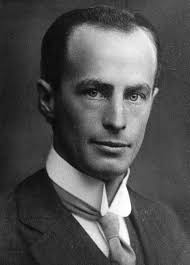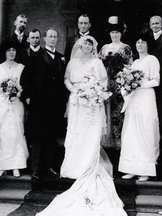A synopsis of Mawson's life
 The name of Sir Douglas Mawson is synonymous with Australia's Antarctic history. He was a true pioneer,
venturing into unknown, hostile territory, and almost losing his own life, in the cause of science.
The name of Sir Douglas Mawson is synonymous with Australia's Antarctic history. He was a true pioneer,
venturing into unknown, hostile territory, and almost losing his own life, in the cause of science.
Born in Yorkshire, England in 1882, Douglas was just two when his family moved to Sydney. Educated first at Fort Street Model School and then (from age 16) at the University of Sydney, Douglas graduated in Engineering and Science. During this time he came under the influence of Professor Edgeworth David, the leading Australian geologist of the day. His first published paper was on the Geology of Mittagong, a work done with his fellow science student and friend T. Griffith Taylor, later to make his mark in Antarctic science. In 1903, before completing his science degree, he made a geological survey of the New Hebrides (Vanuatu) and in 1905 produced one of the first major works on the geology of Melanesia.
Mawson became lecturer in mineralogy and petrology at the University of Adelaide in 1905, describing radioactive minerals from Radium Hill and undertaking extensive fieldwork in the Barrier Ranges (including Broken Hill), where he studied past glacial activity. His work in Broken Hill brought him into contact with G.D. Delprat, the General Manager of B.H.P., whose daughter Paquita he would marry in 1914. Mawson's first field trip to the Flinders Ranges, an area where he would study in detail in later years, took place in February 1906, in conjunction with Walter Howchin and Griffith Taylor.
In November 1907 Mawson met Ernest Shackleton in Adelaide with a view to joining Shackleton's proposed British Antarctic Expedition to study glaciation in action. Shackleton appointed him physicist for the expedition, departed that summer for the Ross Sea. Mawson was 26. Also on the expedition was Mawson's mentor, Edgeworth David.
 In March 1908 Mawson was a member of the team led by David which climbed Mount Erebus, Antarctica's only
active volcano. The following summer, again in a party led by David, Mawson
journeyed on foot for over 2000 km to the region of the South Magnetic Pole
and back to
the Ross Sea coast - the first to reach this elusive goal. The expedition
almost ended in disaster, with David crippled by cold and Mawson having to be
rescued from a crevasse.
In March 1908 Mawson was a member of the team led by David which climbed Mount Erebus, Antarctica's only
active volcano. The following summer, again in a party led by David, Mawson
journeyed on foot for over 2000 km to the region of the South Magnetic Pole
and back to
the Ross Sea coast - the first to reach this elusive goal. The expedition
almost ended in disaster, with David crippled by cold and Mawson having to be
rescued from a crevasse.
Back in Australia Mawson determined to return to the icy continent to explore the coast to the west of Cape Adare, due south of Australia. He contacted Robert Scott, who was planning an attempt to reach the South Pole and invited Mawson to join his South Pole sledging party. But Mawson the scientist had no interest in such non-scientific endeavours. He turned to Shackleton, who though interested was unable to raise the finance needed. Mawson resolved to lead his own expedition.
After a prodigious fund-raising effort, he raised the capital (about $15m in today's dollar terms) and put together the equipment, supplies and men for his own 'Australasian Antarctic Expedition', which departed Hobart aboard the ship Aurora, captained by John King Davis, in December 1911. On Macquarie Island he left a small communications crew who would relay the first wireless signals from Antarctica to the world.
Mawson set up two Antarctic exploring bases, one on the Shackleton Ice Shelf under Frank Wild and the main base under his leadership at Cape Denison in Commonwealth Bay, south of Tasmania. At each base he and his men undertook a series of carefully-planned scientific investigations, including intensive land exploration along the coast and into the hinterland. The Commonwealth Bay base he later called 'The Home of the Blizzard' because of its exceptionally powerful and persistent katabatic winds.
Mawson himself led the Far Eastern Sledging Party with Belgrave Ninnis, a Leiutenant of the Royal Fusiliers, and Xavier Mertz, a swiss Doctor of Law, ski champion and mountaineer. After five weeks and 500 km out disaster struck: Ninnis, with one of the two sledges and most of the party's supplies, was lost down an immense crevasse. Mertz was to die on the return journey, possibly from Vitamin A poisoning from eating the livers of husky dogs. But Mawson survived after an epic solo journey of a month, during which he had to haul himself on the end of a rope out of a deep crevasse. It is one of the great polar stories of survival.
 Mawson returned to the base only to see his ship Aurora on the horizon on its way to collect
the Western Party under Wild. The ship was unable to return because of the risk
of being beset by ice with the brief summer season nearing its close. Mawson
remained behind with six companions to recover from his ordeal before returning
to Australia the following summer.
Mawson returned to the base only to see his ship Aurora on the horizon on its way to collect
the Western Party under Wild. The ship was unable to return because of the risk
of being beset by ice with the brief summer season nearing its close. Mawson
remained behind with six companions to recover from his ordeal before returning
to Australia the following summer.
 On Mawson's return to Adelaide, he was treated as a hero by delighted crowds. His great achievement
as an Antarctic leader and scientist were later recognised with a knighthood
bestowed by King George V of England.
On Mawson's return to Adelaide, he was treated as a hero by delighted crowds. His great achievement
as an Antarctic leader and scientist were later recognised with a knighthood
bestowed by King George V of England.
In 1914 Douglas Mawson married Paquita Delprat, to whom he had been engaged since before his departure for Antarctica. The 'letters' they wrote to each other during his Antarctic absence have recently been published. They were to be a close couple and family (two daughters) throughout their long lives.
Mawson returned to the Antarctic twice more, in 1929/1930 and 1930/1931, as leader of the first and second summer voyages of the British, Australian and New Zealand Antarctic Research Expedition (BANZARE), concentrating on oceanography, Antarctic and subantarctic marine biology, and Antarctic coastal exploration to the west of the Shackleton Ice Shelf. Mawson's ship was Scott's old vessel, Discovery, and the captain on the first voyage was again John King Davis.
 Like the Australasian Antarctic Expedition before it, BANZARE was an immense scientific success,
producing an enormous amount of data about the Southern Ocean to build on the
already-significant Challenger expedition some 60 years earlier. The
territorial exploration also had its rewards. Mawson claimed for Britain all
the land of East Antarctica between longitude 40 deg. E and 160 deg. E with the
exception of the small sliver of Adelie Land, claimed by France. The
territorial claim - 42 percent of all Antarctica with an area the size of
Australia without Queensland - was transferred to Australia in 1935.
Like the Australasian Antarctic Expedition before it, BANZARE was an immense scientific success,
producing an enormous amount of data about the Southern Ocean to build on the
already-significant Challenger expedition some 60 years earlier. The
territorial exploration also had its rewards. Mawson claimed for Britain all
the land of East Antarctica between longitude 40 deg. E and 160 deg. E with the
exception of the small sliver of Adelie Land, claimed by France. The
territorial claim - 42 percent of all Antarctica with an area the size of
Australia without Queensland - was transferred to Australia in 1935.
 Sir Douglas Mawson lived out his life in Adelaide, working as Professor of Geology at the University of
Adelaide and devoting his leisure time to family, farming and forestry. He
became a dedicated conservationist, arguing forcefully and effectively for the
protection of Macquarie Island wildlife from the depredations of hunters.
Sir Douglas Mawson lived out his life in Adelaide, working as Professor of Geology at the University of
Adelaide and devoting his leisure time to family, farming and forestry. He
became a dedicated conservationist, arguing forcefully and effectively for the
protection of Macquarie Island wildlife from the depredations of hunters.
He also became a persistent lobbyist for a permanent Australian presence in the Antarctic. In 1947 his efforts were realised with the dispatch of the first Australian National Antarctic Research Expeditions (ANARE) to Heard and Macquarie Islands. Mawson joined the ANARE Executive Planning Committee, which he continued to serve into his old age.
ANARE finally reached the continent of Antarctica in 1954 where a station was established on Horseshoe Harbour, Mac Robertson Land. It was named, fittingly, Mawson.
Sir Douglas Mawson died in 1958 at the age of 76.